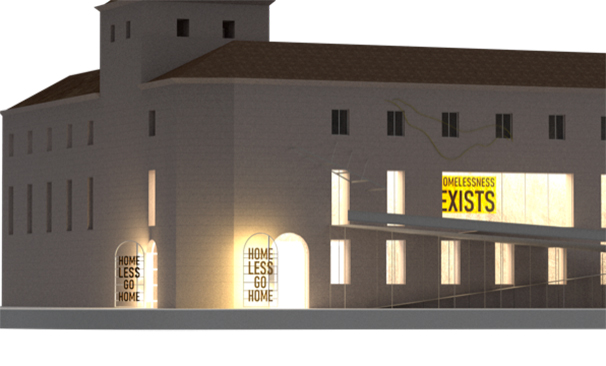What are you looking for?
You might be looking for...
Sense llar
Eva Serrats + Francesc Pla + Daniel Cid

Obra
Blocking the way to a porch with gates, putting spikes in the ground or installing individual benches? Are these the solutions to homelessness? Actually, they are ambivalent control elements that do not punish homelessness but exclude it. In short, they suggest that one is not welcome. In addition to physically displacing the problem, these barriers make it invisible. It is an idealisation of the city, a " statisation" of public space that denies the conflict. A conflict that, however much we insist on refusing, will continue to exist. The denial is probably an act of self-protection, seeing someone sleeping in the street highlights our fragility and the fragility of the system in which we live. We need to activate ignored visions, broaden the superficial definitions of homelessness and legitimately include it in the city. We need to break down prejudices and understand that "chronic" homelessness ends up breaking the bonds of the person who, living nowhere, has nowhere to go. They are not on the street because they want to be, but because they have nowhere to live, nowhere to go, nowhere to enter and leave whenever they want. He neither deserves it nor has he asked for it. The causes of homelessness are structural. The homeless identity is constituted on the basis of what it lacks, a home. A dislocated experience that always takes place in the open, in a continuous transition of appropriation and re-appropriation of the street. And when barriers appear that prevent this, the person is directly criminalised, their stress and anxiety increases, their rights are violated, their day-to-day life is made more difficult. We propose an estrangement, taking the doors out of their automated perception and taking them away. To make visible this invisibilisation we were talking about and at the same time, in an exhibition about the home, to make it evident that inhabiting is constituted in the transits that go from the bed to the street. Crossing the thresholds between intimate, private, collective and public spaces. We enter the house because we have gone out before.
Instagram
@leveproductora
@evaserrats
@danielcidmoragas
Facebook
@leveprojects
Twitter
@daniel_el_cid
@EvaSerrats
Authors: Eva Serrats + Francesc Pla + Daniel Cid
Eva Serrats (Lier, 1971).
She is an architect, Master in creative documentary and currently a student of the Master in Philosophy for Contemporary Challenges (UOC). She has worked in the fields of photography, film, architecture and cultural management, among others. In 2007 she created Leve Productora, located in La Floresta. She is director of strategy at the La Capell Cooperative, of which she has been president (2019-2021). She has been a lecturer on the Degree in Cultural Communication at the University of Girona. She currently teaches projects at the ETSAB (UPC).
Francesc Pla (Barcelona, 1968).
He studied architecture in Barcelona. For almost 23 years he has been a partner of BOPBAA together with Josep Bohigas and Iñaki Baquero. He is currently developing architecture and museography projects with Eva Serrats at Leve Productora. The projects they work on have different themes, motivations and formats: housing for the homeless, food sustainability, luxury, housing typologies, infrastructures in the landscape, territory... in architecture, urban planning, cultural events, etc. projects. Part of his daily work is the architecture as a service to the neighbourhood and the involvement in the definition of projects to improve the neighbourhood. He is an architect for the Environmental Sustainability Plan in the Metropolitan Area of Barcelona, and professor of projects at the Vallès School of Architecture (ESTAV-UPC).
Daniel Cid (Barcelona, 1966).
He is Associate Professor of Design Studies at Winchester School of Art, University of Southampton (UK). His research moves between theory and praxis. He has published books such as Las casas de la vida (with Teresa Sala, published by Ariel in 2012) and La casa dispersa (Asimétricas 2020). He has recently published the novel El espacio de un instante with Ampurias (Casero Prize). He is co-director of the WSA Social Practices Lab, a project that explores how design through academia can activate community projects. He has developed, among others, participatory projects with communities affected by homelessness.
The three have worked together on projects such as Zero Floor, a new type of low-demand temporary housing for homeless people, which proposes an alternative formula for guaranteeing access to housing. A conventional dwelling is refurbished to transform it into a "street flat" that offers the possibility for people sleeping rough to spend the night. It is aimed at people who have failed in other forms of overnight accommodation, due to their refusal or inability to adapt to certain rules of conduct and coexistence that are often required. The first case study was in Carme Street in Barcelona, and two new versions are currently being worked on: one in Llatzeret Street in the same city and by the same organisation, and another in Mahon by the Island Council of Menorca (the latter together with Ferran Vizoso).
Collaboration: Juan Lemus, Arrels Fundació
Production: Leve Productora
Aknowledgements: Gabriel Aguirre
Resource map "Surviving on the street in Barcelona" - Arrels Fundació:
https://www.arrelsfundacio.org/mapa-sobreviure-al-carrer-a-barcelona-agost2020/
Architectural elements that violate rights - Arrels Fundació:
https://www.arrelsfundacio.org/arquitectura-hostil/
Zero Floor – Leve Projects:
http://www.levenet.com/projecte/pis-zero-darrels-fundacio/
